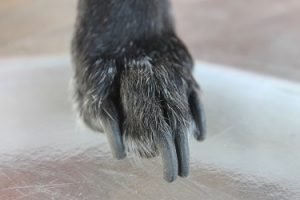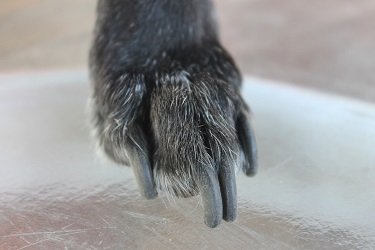Discoloration of dogs’ nails is very much a symptom of some problem going on in the body. If you are worried about “why does my dog have black nails?” Then this article is for you to read.

Dog nail color black
Dog nail colors depend on his breed and fur color. Mostly white dogs have white nails and brown or black dogs have black nails. Some dogs have bi-colored nails too. So are black nails normal for dogs? Yes, if your dog is healthy and has no other noticeable issue, nail color doesn’t matter.
When dog nail color starts fading and nails are becoming brittle and weak, this is a concerning situation. A change in existing nail color means your dog’s body is suffering in some way.
Why does my dog get a black nail?
When dog nails are turning Black, there could be various reasons. Possible answers to what does Dog black nails means are
Infection in nails
When there is an infection in dog nails, they start becoming black. This is due to germ building in the infected area. In fungal infection, not only the nails but also the surrounding area can get infected.
A dog moves to different places daily. His feet come in contact with anything on the ground. He can pick up dirt, grease, oil, mud, soil, and even feces of other animals. A bacterial or fungal infection manifests more quickly on dog nails if the nail is already broken or cut wrong.
If the nail is more bluish or greenish-black, this is a symptom of fungal infection and if the nail is more brownish-black, the dog has a yeast infection.
Any infection in dogs’ nails usually doesn’t stay in nails only. It can affect dogs’ paws and legs also. If you notice your dog
- Is Limping (Read can long nails make a dog limp)
- Doing constant itching
- Is restless (also read diabetic dog restless at night)
- Has Swollen paw
- Discolored nails
- Marks on nails
- Has discolored skin patch on paw
- Is constantly rubbing his paw with his tongue
Then the first thing you should be checking is a fungal or bacterial infection. This infection must be treated a soon as you know they exist. Otherwise, they can spread through paws and sometimes even the whole body.
Nail accident
Especially when a dog has long nails, they are more prone to accidents. When your dog accidentally bumps his nail, not only the nail itself but also the nerves in nails can get damaged. Internal nail bleeding can cause bluish marks which turn black over time.
Sometimes nail breakage also leads to black-colored nails in dogs. Handle any nail trauma carefully and if your dog is showing other symptoms too, it could be a serious health threat.
Age
Age is another common factor in your dog’s nails turning black. Mostly dog nail color depends on skin pigmentation and changes with age. Genetics plays an important part here. Many dogs born with white nails can have black nails over time. Many owners ask “why does my dog has some white nails and some black?”.
Well, This is not concerning unless your dog is showing other symptoms. In old age, dogs are also prone to arthritis and bone problems so to rule out any threat, keep an eye on dogs’ overall activity for any additional symptoms.
Allergy
When dog nails have black or maroonish marks or spots, this is usually due to an allergic reaction. Allergic reactions can also trigger bacterial infections in nails. To treat this you just have to avoid things that cause allergy to your dog.
Detached nail
Sometimes when the nail is broken and detached from the quick it starts turning black which falls off eventually. Dogs don’t shed nails. This is more like a decaying process which is not concerning usually. If the nail is broken from the quick part, it will be very painful for dogs.
Autoimmune disease
Dog breeds like German shepherd or Greyhound are more prone to autoimmune diseases which target nail health. SLO is an autoimmune disease in which a dog’s nails can turn black. However, the condition is rare.
Neuropathy
Neuropathy is when the connection between nerves and the brain is distorted. Some time diseases like diabetes trigger neuropathy especially in the feet which can cause black nails. (Read diabetic dog neuropathy).
Cancer
Black nails could be due to a tumor or cell growth in a body. These tumors are not necessarily present in paws only. Cancer anywhere in the body can trigger bad health and black nails.
How to treat black-colored nails in dogs?
Dog black nail treatment depends on the reason for black-colored nails.
- When nails are black due to infections, your vet will prescribe antibiotics to kill germs.
- In the case of fungal infection, antifungal therapy is recommended. Fungal infection is easier to cure in the early stages.
- The vet may prescribe ointments and creams to treat infection or wounds in nails.
- Cauterization can be done to seal wounds on dogs’ nails. (also read cauterize dog nails).
- Sometimes surgery is the only option to treat black-colored and fully damaged nails. (Read dog nails too long surgery).
How to prevent black color nails in dogs.
- Nail care routine prevents broken and brittle nails. (read dog nail peeling). This is a simple step you can take to prevent dog black nails.
- Always keep your dog’s nails clean. Untidy nails are unhealthy. They can trigger fungal and yeast infections. So cut, trim and cleanse your dog nails regularly.
- Use sandpaper to keep the dog’s nails filed. This way your dog’s nails will not grow long enough to cause accidental breakage or peeled nails. (also read what grit sandpaper is for dogs?)
- You can use a nail cutter or nail grinder but be cautious not to cut the quick part or you may be responsible for your dog’s black nails yourself. (Also read dog bites when cutting nails).
Conclusion:
Dog nails could be due to various reasons including fungal infections to rare autoimmune diseases. However, with routine care and proper treatment, you can sort out the problem. Also black nail color is common in some dog breeds.

